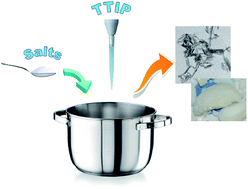The hypersaline synthesis of titania: from powders to aerogels†
Abstract
High surface area mesoporous titania has been synthesized using ordinary salts (chlorides) for morphology control during the sol–gel process. Applying Ti-alkoxide (TTIP) as a titania precursor and a highly-concentrated hypersaline medium, different results have been obtained according to the dispersing medium selected. By working in an acid environment, the hypersaline medium controls the oxide network growth, since different salts (and different salts amount) influence the surface area, porosity, crystallinity and polymorphs rearrangement of the final material, favoring the formation of acicular-like rutile at mild conditions. Nevertheless, it has been verified that, according to the Hofmeister series, salting-in ions induce an increase in the titania surface area, going from 79 (for the reference, without any salts) up to 253 m2 g−1 (for the Li-templated titania). By working in alcoholic media, the hypersaline environment favors the gelification process and the formation of amorphous titania aerogels or highly-porous monoliths, according to the drying conditions selected (respectively supercritical CO2 or ambient pressure air drying). Two different alcoholic media (ethanol and 2-propanol) have been compared. Such salt-templated titania aerogels are mesoporous (with BET surface area comprised between 322 and 490 m2 g−1). Besides the surface area, even the pore volume and the pore size can be controlled by both the reaction medium and the drying step: in particular, air-dried monoliths are small mesoporous (BET surface area between 419 and 518 m2 g−1). Reference materials synthesized in alcoholic media without using any salts do not gelify (thus confirming the importance of the hypersaline medium), whereas titania particles precipitate, inducing aggregation into small mesoporous powders. In general, the hypersaline-mediated titania production seems to be an interesting chemical toolbox, sustainable, highly efficient and also potentially suitable for industrial scaling-up.


 Please wait while we load your content...
Please wait while we load your content...